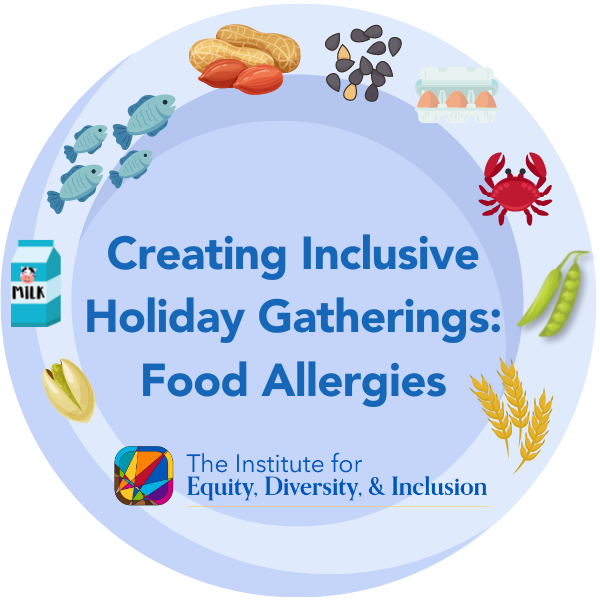(12/9/22) In popular culture, food allergies are sometimes mocked or taken lightly. In reality, they can be serious medical conditions, affecting millions of us every year. As we gather with loved ones this holiday season, we wanted to shed a little light on what food allergies are and provide tips on how to ensure your holiday gatherings are inclusive of everyone’s dietary needs.

What are food allergies anyway? What is anaphylaxis?
Food allergies are one of the most common and continuously growing immunological chronic health conditions. They can (and do!) affect people of all ages, including young children and older adults. Symptoms can include hoarseness, cough, wheezing, chest tightness, nausea, vomiting, diarrhea, fainting, and anaphylaxis. Food allergy reactions might not look the exact same each time you encounter an allergen and may even be affected by factors such as alcohol consumption or exercise. Anaphylaxis is a medical emergency that includes hives, swelling, throat closure, rapidly lowering blood pressure, and shock. Food-allergic reactions are the leading cause of anaphylaxis, and they can be life-threatening. If you or someone you are with is experiencing anaphylaxis, administer epinephrine and go to the ER right away. Learn more here:
Food Allergy Awareness Flyer.pdf (329.63 KB)The greatest concern for adults with food allergies is the inability to identify foods that are safe to eat. Is there anything in place to make that easier?
Yes! In 2004, the Food Allergen Labeling and Consumer Protection Act defined 8 major food allergens (milk, eggs, fish, crustacean shellfish, tree nuts, peanuts, wheat, soybeans) and implemented specific labeling requirements. These requirements include an ingredient list or separate “contains” statement on all FDA-regulated packaged foods including dietary supplements.
On January 1, 2023, the Food Allergy Safety, Treatment, Education, and Research (FASTER) Act will roll out. This Act requires a 9th allergen- sesame- to be added to the list of major food allergens.
Everything you need to know about food labels and how to read them
First off, always read packaged food labels, even if you have purchased that exact item before. If you are having trouble reading a label, ask for help from someone you trust. Food labels are required to list the 8 (soon to be 9) most common allergens and are often located on the back of a package. It is important to note that molluscan shellfish (oysters, clams, mussels, scallops, etc.) are not considered a major allergen.
You will either see the ingredient listed using the allergen’s common name (ex: eggs), using the word “contains” followed by the name of the major food allergen, or in the ingredient list in parentheses ex: albumin (egg).
With tree nuts, fish, and crustacean shellfish, the specific type must be listed (ex: almond, tuna, crab).
Language such as “May Contain” /” Processed in a facility that also processes”/” Made on equipment with” is voluntary for manufacturers. Treat “may contain” labels as though the food item does contain the allergen in question. Additionally, please note that phrases such as “peanut free” and “egg free” are not regulated.
How to create an inclusive holiday gathering experience
If you have food allergies: If you don’t see a label, skip that food item. . Look up uncommon names of your allergens just in case. When in airplanes or traveling, keep your epinephrine close, such as on your body/under your seat. Educate those around you about how to use your epinephrine, including family, friends, and co-workers. Let them know where your epinephrine is and make sure it is always in that place. Be mindful of your epinephrine’s expiration dates and any temperature limitations it may have. Always let your host, restaurant, or server know about any allergies you have and how they should be accommodated. If someone around you is eating an allergen, take it seriously. Your safety is priority, do not be afraid to leave a gathering if necessary. If it is safe and comfortable to do so, approach your co-worker or loved one about your allergies and individual situation surrounding them.
Having food allergies is not easy. The burden of avoidance, fear of exposure, past traumatic reactions, and the experience of not being taken seriously can result in anxiety, frustration, and internalization. Treat yourself kindly. You’re not overreacting or making things up by taking care of yourself.
If your guest has food allergies: When preparing or purchasing meals for guests, always ask about religious and medical dietary restrictions as well as food allergies well in advance, so both you and your guest can prepare. Have separate utensils for the allergen-free food items to avoid accidental cross-contamination. Disclose to your guest(s) if you aren’t 100% sure about all the ingredients in a dish or if you forgot to read the food label for a particular ingredient. If someone approaches you about a food allergy you didn’t know about ahead of time, don’t react in frustration. Be honest about what food items contain the allergen(s) and how you can best support your loved one.

